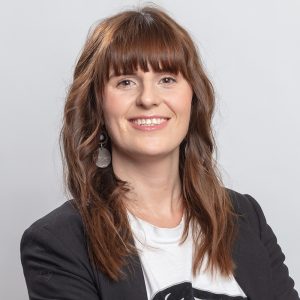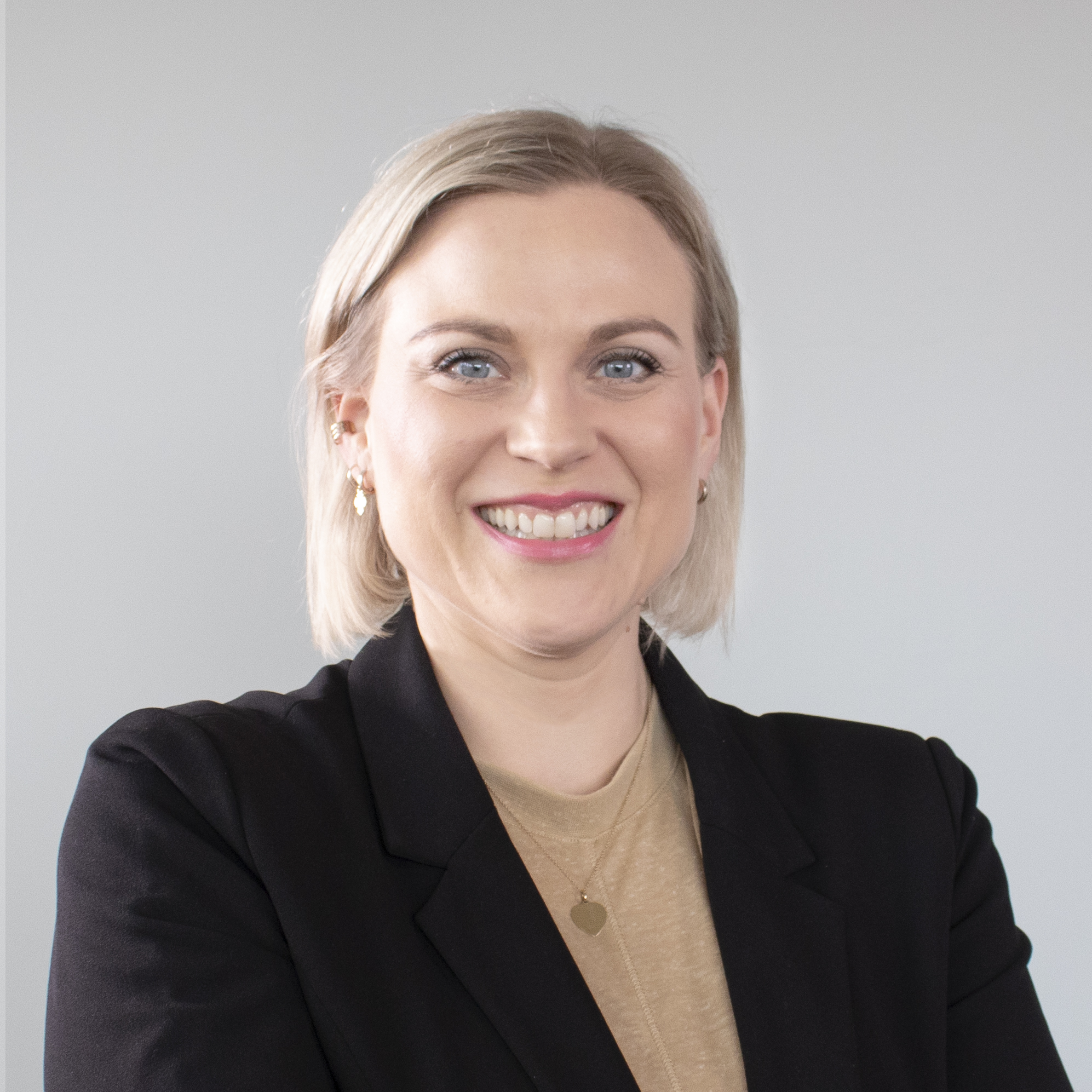
Dismantling unconscious prejudices and appreciating diversity in the company
Tips for dealing with unconscious bias - Interview with Vanessah Aurore Reck
The tricky thing about unconscious bias is our failure to acknowledge that it is part of human nature to apply stereotypes in our thought processes. We all have stereotypical expectations, as well as prejudices. The more we acknowledge that, the more we can reflect on it and the better we can handle it. That is why we invited Vanessah Aurore Reck for International Diversity Day. She is offering an impulse session on unconscious bias to our employees. I met with her in advance to discuss these topics, as well as diversity and inclusion in general.

INFO
Vanessah Aurore Reck teaches intercultural management at Saarland University in Saarbrücken. She is currently writing her PhD thesis on integration. She has a thematic and personal connection to the topic.
Vanessah grew up in Madagascar. She moved to Germany at the age of 12, and continued her studies there. After graduating from high school, she studied intercultural communication, Spanish and law in Saarbrücken. She explains that this sparked her passion for intercultural issues.
Working on her PhD thesis, she is examining which factors contribute to successful integration.
Hello Vanessah! Thank you for taking the time. I will start with my first question: What does diversity and inclusion mean for a company? What benefits does active D&I management bring?
That depends on the corporate culture. Is it still necessary to use diversity as a selling point to attract good applicants? Or has it already become standard practice? In fact, maybe diversity no longer is the actual topic, but rather the corporate culture itself? Having a culture in which all employees thrive regardless of their backgrounds and such?
I’m under the impression that these topics have not yet been discussed in such breadth in Germany, as has been the case in the USA or other English-speaking countries. Thus, companies in Germany should ask themselves what role diversity plays in their own corporate culture and the company’s identity. For example, diversity might be of greater significance for companies with global operations where communication is key. However, no company should have to put diversity and inclusion on the agenda – at least not beyond the legal requirements. A far more interesting question for a company might be: How can diversity help an organisation achieve its goals?

You are going to talk about the issue of unconscious bias. How would you define that term?
The term is originally rooted in psychology. However, I tend to focus on the cultural science component, and the reasons for its significance in an intercultural working environment. We have to remember that a bias is typically based on stereotypes and prejudices. In most cases, it is an attitude that we are not aware of, but this unconscious perception can lead to conscious discrimination.
This transition from unconscious to conscious is what creates issues. That is when you arrive at an extreme attitude, such as racism. It is important to differentiate these terms clearly.

At what point is it important for a company to deal with this topic?
It becomes crucial when a global corporation like Google strives to attract the crème de la crème of employees. Clearly, this crème de la crème is not just composed of white 50-year-old men. It is very diverse. It goes without saying that the company must create a suitable working environment if it wants to acquire such top talents. Taking this further, evaluating this issue is equally beneficial to companies seeking to attract outstanding candidates in other contexts.
The key is to reflect on one’s own unconscious bias – both on an organisational and on a personal level. Thus, awareness needs to be created.
Can you offer practical tips for dealing with unconscious bias?
The standards proposed by the scientific community sometimes appear engineered. Tools like intercultural training or workshops might be of interest. However, this typical form of training has also garnered criticism, as there is concern that they also encourage the reproduction of stereotypes. Nevertheless, such training is a good starting point for creating awareness for the topic, to make people appreciate its importance and spark an interest.
Also, there is more specialized training on unconscious bias that is based on psychological tenets and is therefore empirical in nature. However, that necessitates access to tools for understanding these empirical findings and transforming them into specific actions.
The Harvard Implicit Association Test takes yet another approach. It basically measures how unconsciously biased an individual is.
Personally, I believe it is important to strengthen the communication relating to this topic within the company; to create a shared culture with all employees that also offers safe spaces. This establishes a point of contact for victims of discrimination while also providing a platform for other employees to express their insecurities.
What specific actions would you say managers can employ to minimise bias within their teams?
Participation and communication. Examining and analysing internal processes from a new perspective while involving the affected minority groups.

Cultural Diversity: Working in an intercultural company
Let's have a look at our London and Singapore offices. There are 13 different nations working together in diverse teams.
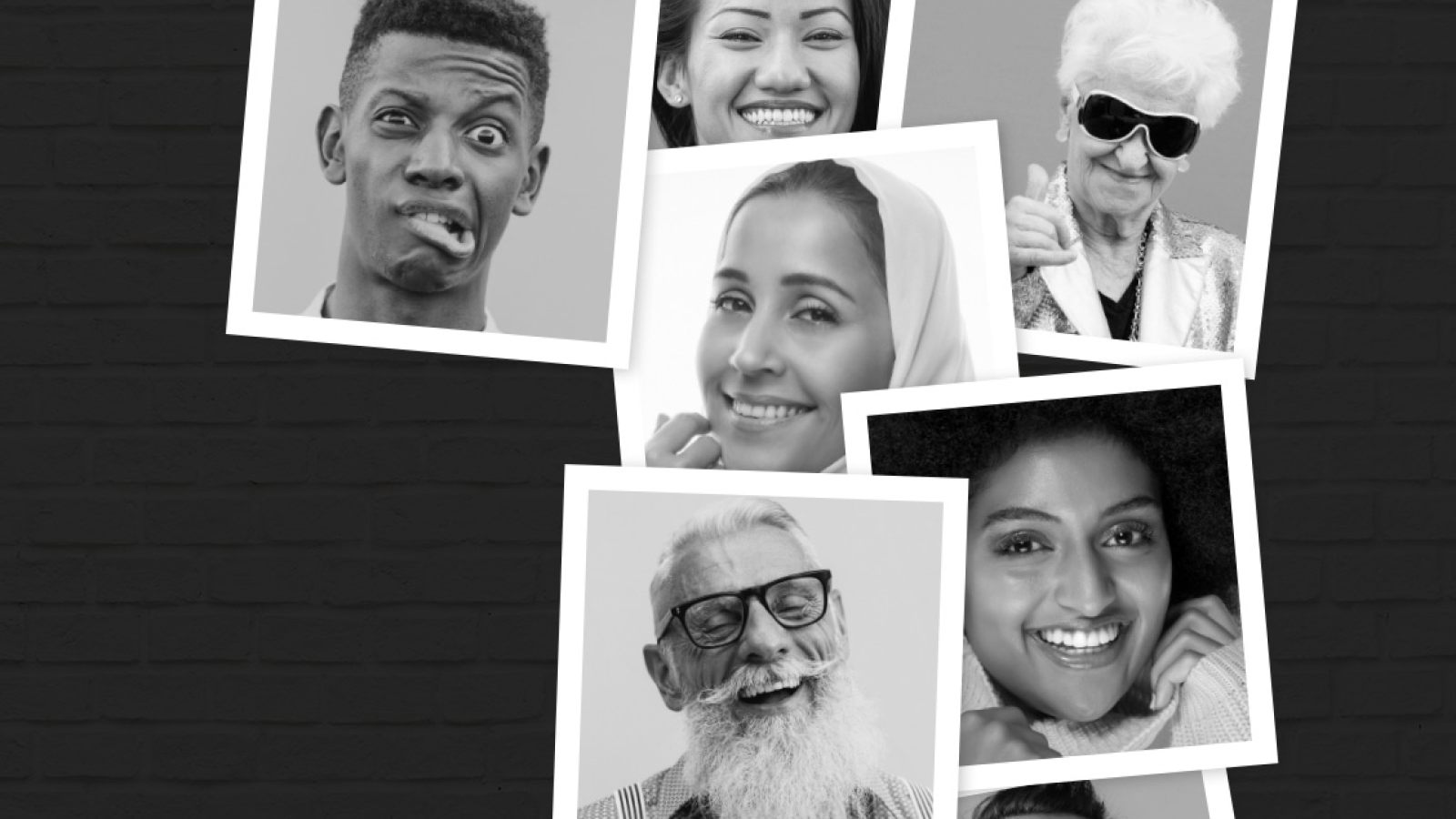
A plea for diverse learning content
Diversity is increasingly becoming a hygiene factor in our working world. E-Learning Content Project Manager Kenny appeals: “The diversity you want must also be reflected in your learning content.”
Contact
I joined the imc newsroom team in 2021. As a journalist my heart beats for content and storytelling.
I’m excited to figure out how e-learing and digitization affect the future of work. My task is to create content to talk about and I’m always looking for trends.
Privately I love to travel and eat Tapas.
Topics: E-Learning Trends, Corporate Social Responsibility, Press and Influencer Relations

Because cultural diversity enriches us
Meeting for a coffee with our colleagues in London and Singapore
It is now widely accepted that a relationship between diversity and business success exists. Studies prove that greater diversity equals greater success. On top of that, employees also benefit from an open corporate culture.
A dedicated crew has formed at imc to further drive diversity and inclusion. The objective: making a mark for diversity.

49 nationalities across 12 locations
Our offices are spread across the world – across 12 international locations to be precise. Here, 49 nations are collaborating. Today, we will take a closer look at two of our offices. To this end, we met for a virtual coffee with Francisca Lim, Brand Manager at imc Singapore and Gijs Daemen, Brand Manager at imc UK.
In London, 15 employees of 8 different nationalities are working together. 7 employees of 5 nationalities share the Singapore office.
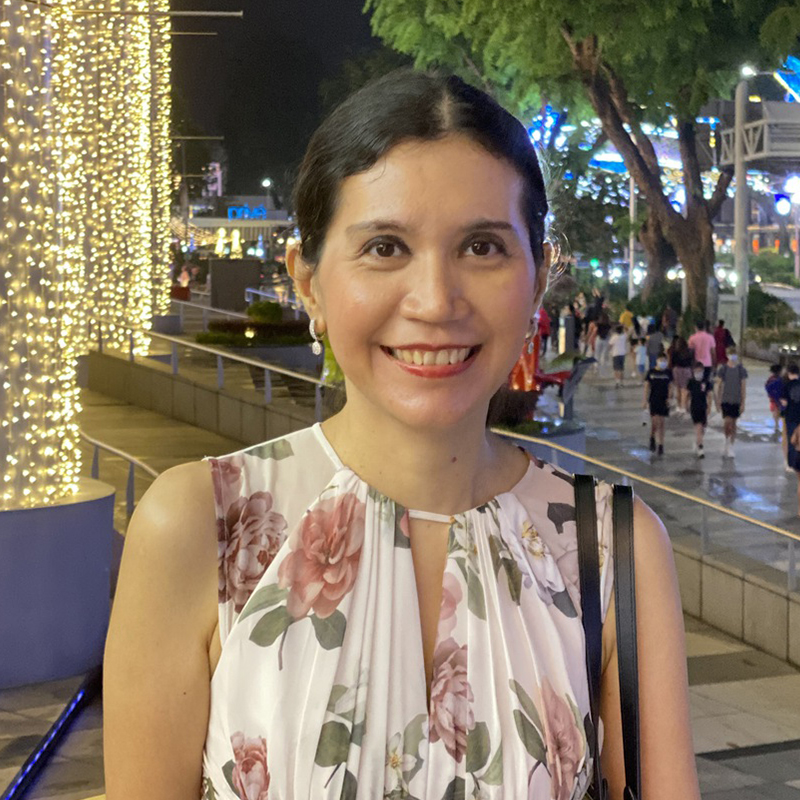
Francisca Lim, Regional Brand Manager, imc Singapore
Francisca, you work in Singapore, but you are from Indonesia. Would you say that there are any differences in the working culture?
The working culture in Singapore is more independent compared to Indonesia. There is an Indonesian term called “gotong royong” or “working together” where everybody is expected to help each other and sharing the burdens. It’s more prevalent in Indonesian work culture than in Singapore. Besides this, there is no distinction between office friends and office colleagues in Indonesia, which is not the same in Singapore. Hence it’s scarce that we can develop a closer bond with our office colleagues in Singapore.
Gijs, you work in London, but you are Dutch. What was the most “shocking” moment for you after moving to the UK?
I can’t think of anything really “shocking”, but I’m very aware of the differences in communication styles. Dutch people tend to be quite direct. In the Netherlands it is seen as being honest and/or being efficient. However, in the UK that directness might come across as rude or disrespectful. So that is definitely something to be aware of.
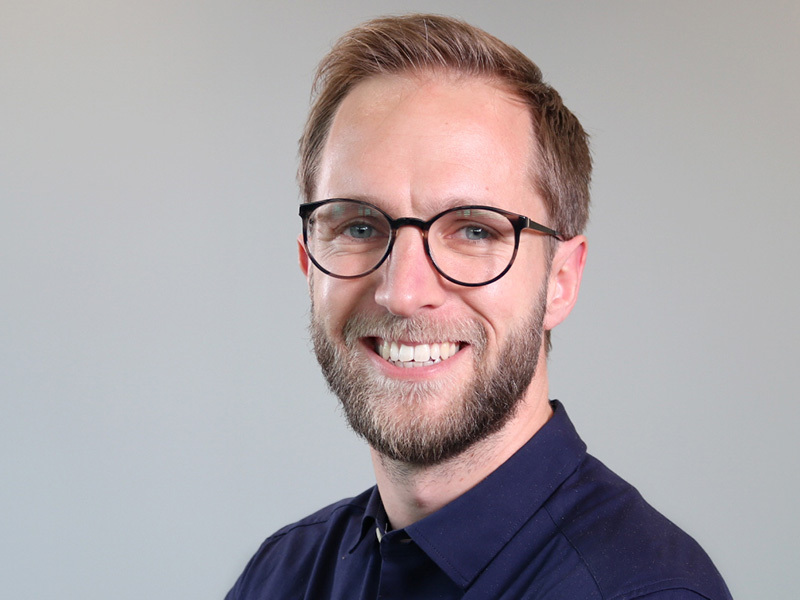
Gijs Daemen, Brand Manager, imc United Kingdom
Is the communication between all of you always in English in the office?
Francisca: Even though the national language in Singapore is Malay, the main language is English. The other official languages are Chinese (Mandarin) and Tamil, besides other dialects such as Cantonese, Hokkien, Hainanese, Hakka and Teochew. Most of the people speak English or sometimes it can be called “Singlish”, a variety of English spoken in Singapore incorporating elements of Malay, Cantonese and Hokkien. There are common words that I never heard before I came to Singapore, such as “lah”, “leh”, “walau”, “blur”. I couldn’t understand the conversation clearly in the beginning, but it’s much better now. However, we speak formal English, not Singlish, in the imc Singapore office.
Gijs: Yes, most of the time it is. A few people speak Dutch though, so sometimes we can switch. German people might be able to follow a Dutch conversation a little bit, but most English speakers won't understand a single word.
Gijs, was there any funny moment, for example a misunderstanding because of the different mother languages?
Our Dutch colleague Tanja loves to use random Dutch words or expressions in English conversations. That can be quite funny, at least for the Dutch speakers among us. I’m not sure what the others think…
Do you see the fact that 49 nations work together at imc as a hurdle or an enrichment?
Francisca: Team members with diverse backgrounds will bring diverse solutions to the table, which leads to a more informed decision-making process and improved results. Harvard Business Review found that diverse teams are able to solve problems faster than teams of cognitively similar people. But there are challenges as well, such as overcoming bias. Studies show that the vast majority of human decisions are based on biases, beliefs, and intuition - not facts or logic. Even with the best intentions, people tend to bring bias into their everyday interactions, including in the workplace.
How do you experience the diversity management at imc, are there still challenges?
Francisca: imc is the only company I joined that has been supporting diversity and inclusion that much, with so many activities and working groups to achieve a better result. I wish that we all keep the momentum going and involve more people in diversity and inclusion activities. There are not many big challenges working in diverse teams as long as we understand each other, share our experiences, learn from each other and understand our differences.

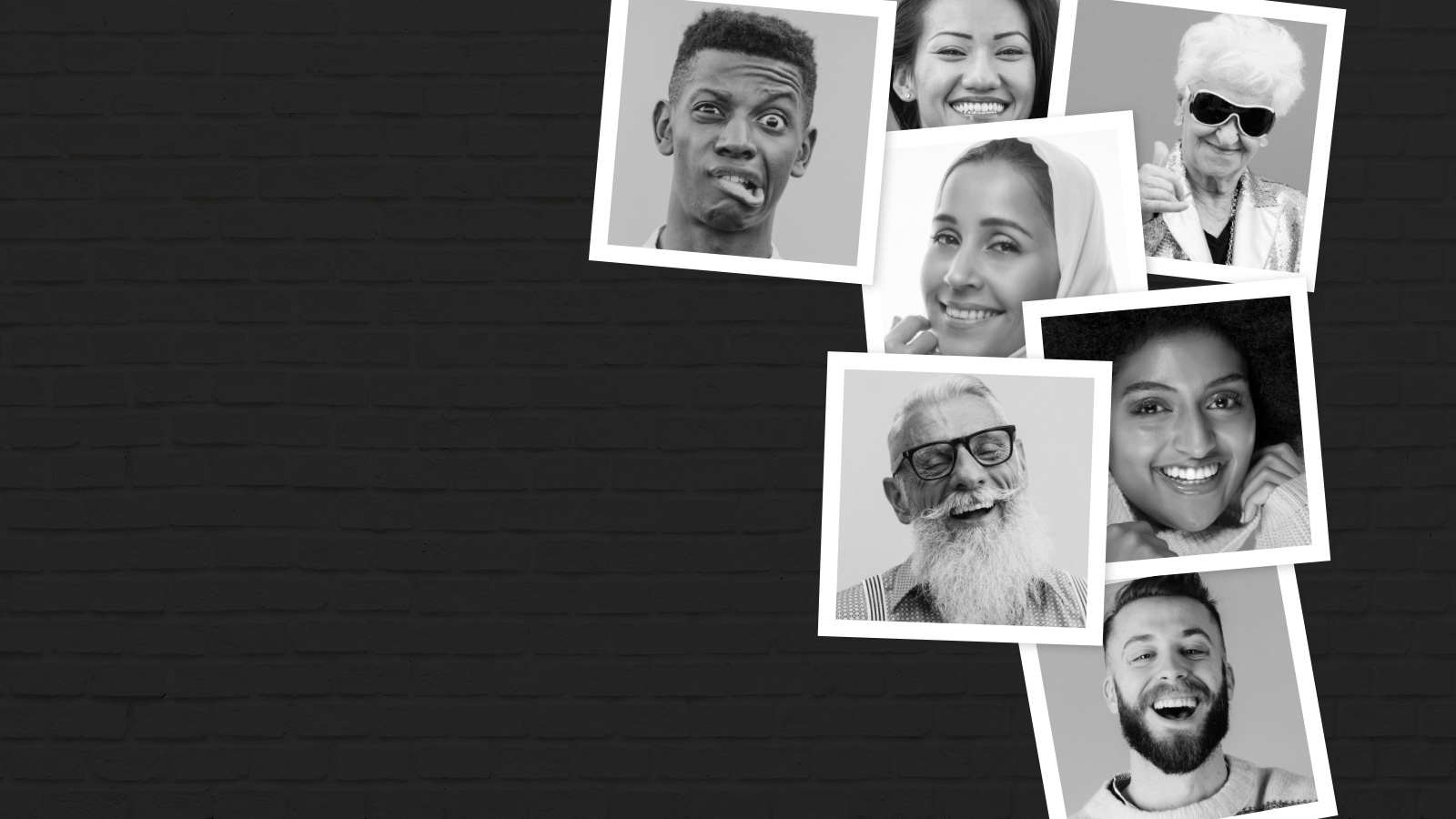
Diversity inspires
The diversity of our employees from more than 49 nations makes us what we are: a Saarland brand at home in the world. Our clients around the world are diverse – so are our teams. Every single day they succeed in enabling individuals and organisations worldwide to unleash their full potential in a continuously changing world.
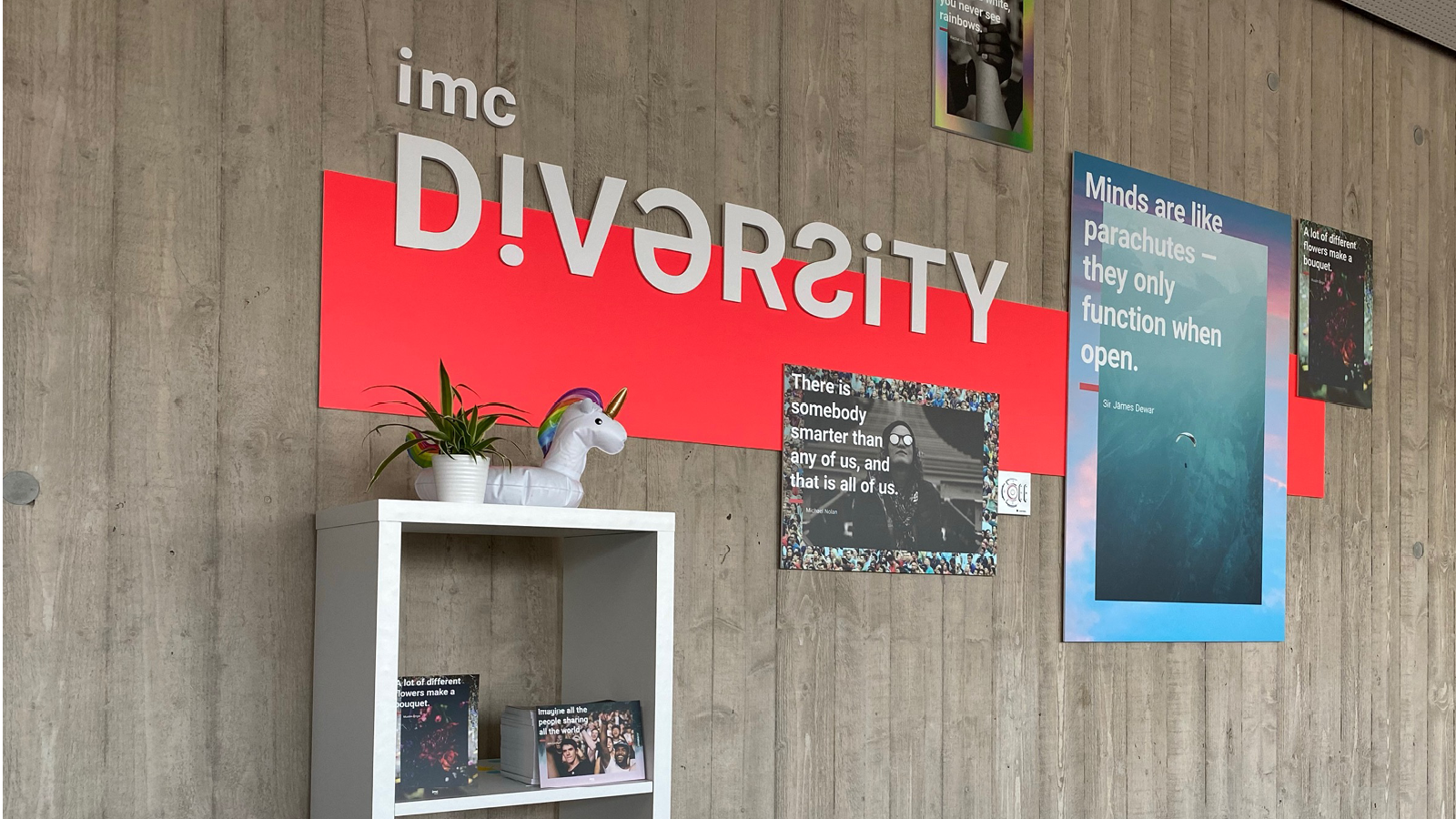
Diversity and inclusion at imc
What does Diversity and Inclusion mean at imc? And what is the "Diversity Corner" in the headquarter in Saarbrücken about? We will enlighten you in the interview with Kerstin Steffen.
Contact
I joined the imc newsroom team in 2021. As a journalist my heart beats for content and storytelling.
I’m excited to figure out how e-learing and digitization affect the future of work. My task is to create content to talk about and I’m always looking for trends.
Privately I love to travel and eat Tapas.
Topics: E-Learning Trends, Corporate Social Responsibility, Press and Influencer Relations

We celebrated International Women's Day 2021
For an understanding of diversity and inclusion we need to talk about bias first
Our team across Melbourne took the International Women's Day as an opportunity to consider diversity, inclusion and equality. The mission: challenging themselves to think about how biases can influence our professional and personal decision making.
International Women’s Day has been a conversation since 1911 and in Australia the gender pay gap is still 13.4%* and there are more CEOs named Andrew (7%) than there are female CEOs (5%) of our top 200 publicly listed companies. (*Australia Bureau of Statistics (2021), Average Weekly Earnings, November 2020, cat. no. 6302.0, viewed 25 February 2021)

In general, there are fewer women employed in technology driven businesses. While at imc we already have comparatively larger percentage of female-identifying staff, we acknowledge that we need to continue to develop and promote initiatives like our ‘Women in Leadership’ program with a view to increasing the number of women we employ.
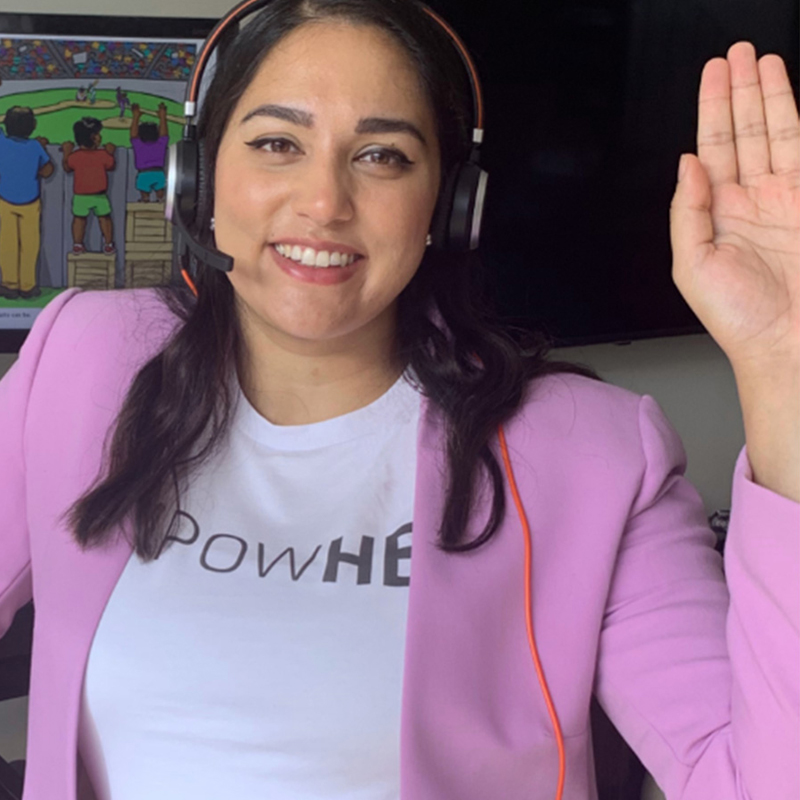
Samantha Mathews
Samantha, instructional designer at imc Australia and part of the imc Diversity and Inclusion Crew, hosted an internal event for her colleagues and talked about diversity, inclusion and why it is important to consider our own biases.
She has been working with a government client on an e-learning solution around family violence risk, an issue that disproportionately impacts women and felt that International Women’s Day was a good opportunity to share what she has learned on this project with the rest of the team.
Samantha, why was it so important for you to celebrate International Women’s Day at the imc office in Australia?
International Women’s Day is a great opportunity to start or re-start the conversation around the social and economic issues that impact half of the workforce.
How did you incorporate this years’ International Women’s Day theme #ChooseToChallenge?
We had a conversation, watched videos, and did an activity around bias, intersectionality, and inclusion. I think people came to their own understanding that “choosing to challenge” is about each of us, as individuals, checking our own biases and speaking up so that collectively, we can contribute to wider conversation about diversity and inclusion.
When we talk about these topics internally, we have an opportunity to reflect and learn which in turn allows us to provide a better, more inclusive service as e-learning providers.

Corporate Social Responsibility
Want to know more about Corporate Social Responsibility and what it means for us at imc? Find out more about our pillars and what we do.

Diversity and Inclusion at imc
What does Diversity and Inclusion mean at imc? And what is the "Diversity Corner" in the headquarter in Saarbrücken about? We will enlighten you in the interview with Kerstin Steffen
Contact
I joined the imc newsroom team in 2021. As a journalist my heart beats for content and storytelling.
I’m excited to figure out how e-learing and digitization affect the future of work. My task is to create content to talk about and I’m always looking for trends.
Privately I love to travel and eat Tapas.
Topics: E-Learning Trends, Corporate Social Responsibility, Press and Influencer Relations

Diversity and inclusion at imc
Let’s celebrate diversity!
– Interview with Kerstin Steffen
I now work at imc in Saarbrücken. New job, new colleagues, new environment. I already noticed in my first week that this environment is not only diverse, but proud of diversity.
When I arrived at the imc headquarters for an initial meeting, one thing immediately caught my eye: The wall in our office features the word “Diversity” in large letters. Underneath is a small sitting area and a merchandise shelf with postcards. Someone had gone to the effort to create something visible – indeed, tangible.
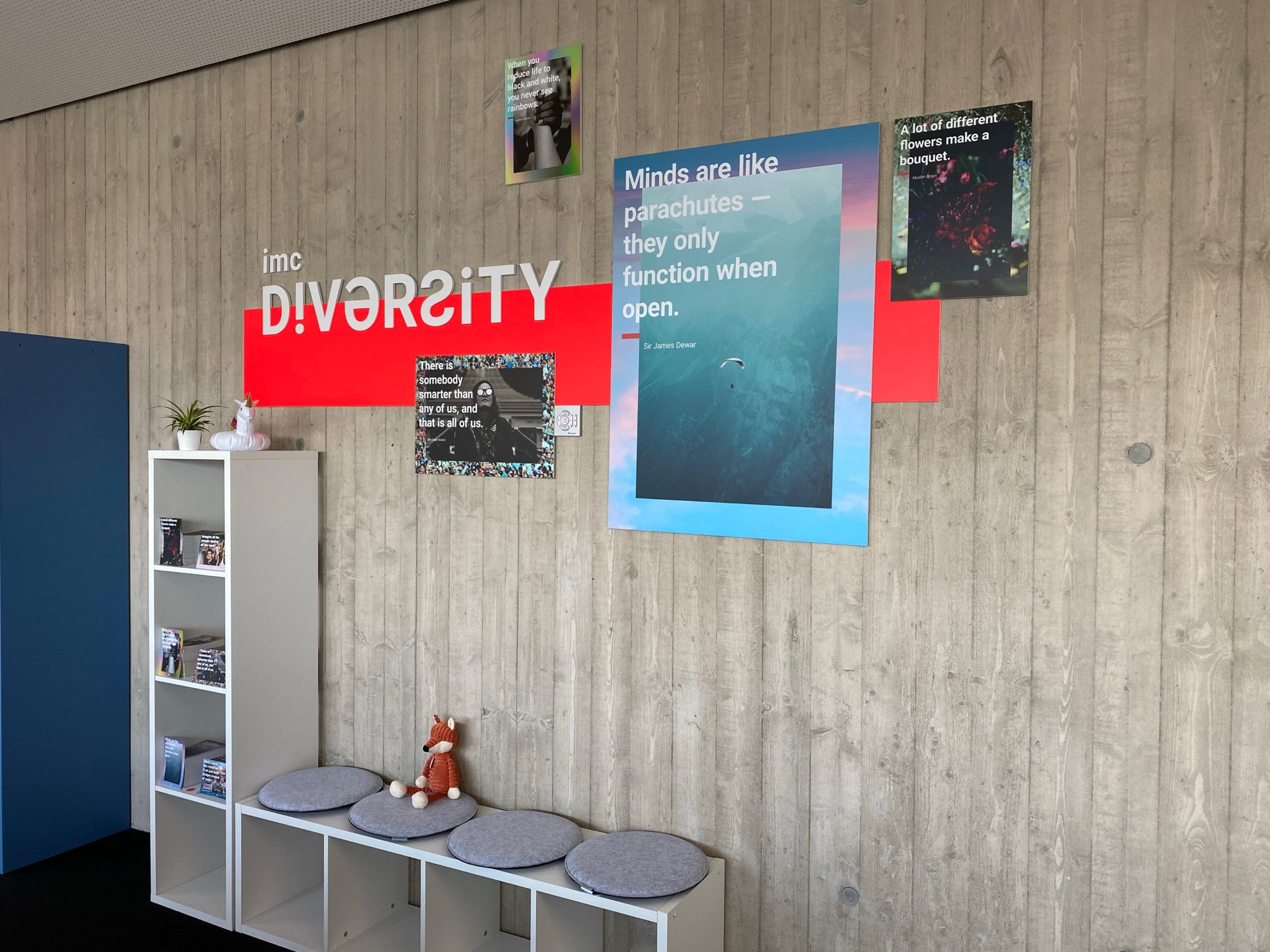
That aroused my interest. I want to know how imc understands diversity, and what exactly the company does to promote and celebrate diversity. Since I am curious by nature, I asked around. The company has a Diversity Crew. Members are based all over the world, but regularly meet virtually to exchange ideas and drive diversity and inclusion. Kerstin Steffen has been part of this from the start.
Kerstin, how did the Diversity Crew come into being? What exactly do you do?
The imc Diversity Crew was established last year. In fact, you could say it is a grassroots movement. Of course, our initiative has no political motivation. Yet, what we all have in common is our desire to bring about (societal) changes.
Colleagues who are invested in certain issues came together. After several discussions and iterations, the three pillars of Women in Leadership, Diversity in Talents and Cultural Diversity were formed. Now, small project teams are working on these topics, continuously extending their reach. Their mission is to organise various programmes and campaigns to make diversity and inclusion visible, and to bring these topics to life.
In particular, we are thrilled that the Executive Board has welcomed our work on diversity and inclusion (D&I), and has given us room to push our topics.

What does diversity mean for imc?
To us, D&I means promoting social diversity among employees, and leveraging it for the company in a constructive way.
Our employees come from almost 50 different countries. Personally, I find that rather impressive. We are working for a large range of customers all over the world. These projects are already very diverse in themselves.
You meet different colleagues from different cultures. They all work with different methods, and have a different understanding of values and beliefs. It is this very difference, this variety, that we consider a great opportunity for reaching the full potential of imc. We also understand diversity as a vital source of creativity. It enables us to come out tops in the global competition for the best ideas and products.
As a company that stands for development and rethinking like no other, we must also ensure that our employees have the freedom and opportunity to expand their horizon, keep learning and take in other perspectives. Making connections with other people and communities, exchanging ideas and benefitting from other people’s knowledge and experience is a win-win situation for each employee, as well as for imc as a whole.
Why does imc have a Diversity Corner? What purpose does it serve?
We created the Diversity Wall to emphasise how important D&I is in our company. The wall represents a diverse workforce and the integrative culture that imc stands for. At the same time, it reminds us every day to be approachable and open with each other.
At the moment, we only have this wall at the headquarters in Saarbrücken. However, we would like to install a wall like that at every imc location.
Your focus in the Diversity Crew is Women in Leadership. Why is that topic so close to your heart?
I moved up to a leadership position at a very young age. I was extremely lucky to have great coaches, colleagues and associates who supported my personal growth in a very male-dominated sector. To this day, I am extremely grateful for the opportunity and the confidence placed in me. I would like to give something back, pass it on. That is why I am actively involved in our Women in Leadership (WIL) Circle.
However, I would like to highlight that WIL means more than just management tasks, line management and responsibility to me. I know many women who have – or are building – impressive careers as experts.
You can also be very passionate about issues you deeply care about or have special talents in your private life. I think it’s important to support each other and help each other be seen. That is the aspect I want to contribute to.
INFO
Women in Leadership is one of the pillars of diversity management at imc. Hence, it’s only natural that we are celebrating International Women’s Day on 8th March. Do you want to see what Kerstin and her team have prepared? Come and visit our social media wall and subscribe to our Instagram channel!

Corporate Social Responsibility
Want to know more about Corporate Social Responsibility and what it means for us at imc? Find out more about our pillars and what we do.

A plea for diverse learning content
Diversity is increasingly becoming a hygiene factor in our working world. E-Learning Content Project Manager Kenny appeals: “The diversity you want must also be reflected in your learning content.”
Contact
I joined the imc newsroom team in 2021. As a journalist my heart beats for content and storytelling.
I’m excited to figure out how e-learing and digitization affect the future of work. My task is to create content to talk about and I’m always looking for trends.
Privately I love to travel and eat Tapas.
Topics: E-Learning Trends, Corporate Social Responsibility, Press and Influencer Relations

A plea for diverse learning content
Why you shouldn’t neglect diversity in e-learning projects
Diversity is increasingly becoming a hygiene factor in our working world. We have arrived in a time where young people are specifically looking for employers that allow them to unleash their potential and to be themselves. Yet, that is not the only reason companies benefit from strategic diversity management. In the German imc E-Learning Inc. podcast, Mohanna Arzamandi, Chief Learning Officer at Microsoft Germany, recently announced: “Diverse teams are better at problem-solving.” Mohanna knows that the Diversity Management and Corporate Learning segments are closely linked.
This starts with training intercultural competences, encompasses barrier-free learning offers and involves illustrating diversity in the actual learning content. We discussed that last point with our E-Learning Content Project Manager Kenneth Littlepage.
“The diversity you want must also be reflected in your learning content.”
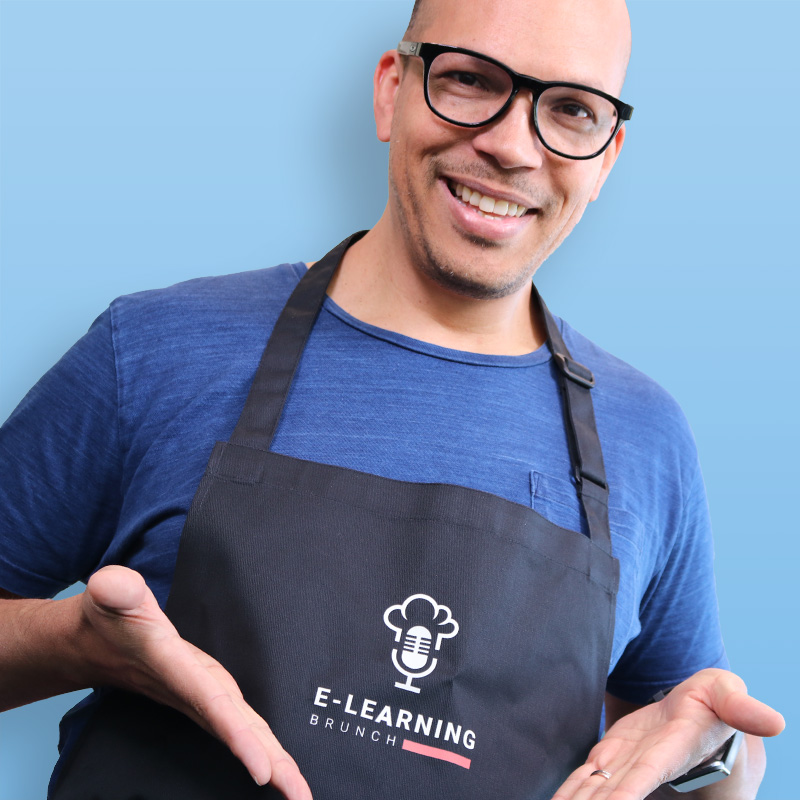
Kenneth Littlepage hosts the English-language imc E-Learning Brunch podcast while also looking after e-learning content as a project manager – a role he has held since 2014. Here, he supports clients from the initial design of learning content to its realisation and implementation. We spoke to him about the role diversity plays in e-learning content projects.
Hello Kenny! What does diversity mean to you?
Kenny: Diversity has several meanings. Most people tend to think of cultural diversity when they hear the term. Yet, there are other aspects of diversity, like workforce or job diversity. For me personally, that primarily means not just sticking to the same routine day in day out, but also being able to realise projects that push the envelope.
You are project manager at imc, looking after clients like the UN, UNICEF, Lufthansa and PwC. How much do your clients really bring up diversity?
Kenny: It always depends on the company. Cultural diversity, at least, plays an increasingly important role in the e-learning projects we realise together with these companies.
Is there a difference between public institutions, national and international companies?
Kenny: Yes, I would say so. The more global a company is, the more sensitised it tends to be to diversity issues. They will often be very direct in their project specifications. Sensitisation is less pronounced among local companies. Then we need to interject and ask: “Hey, should we make a point of XY?”
What specific options are available for realising diversity in content projects?
Kenny: That depends very much on the learning content. Of course, if the presentation revolves around a situation with two persons, it is impossible to consider all aspects of diversity. However, multiple characters can be integrated into most web-based trainings, enabling us to represent different genders and nationalities. We like to use animations. Drawn characters allow for a bit of distance.
How important is it that the content fits in with the real world? For example: If 90% of the managers are white and male, does presenting a multicultural learning environment not come across as dishonest?
Kenny: The real question is: What led to the current situation? Was it intentional? Did it happen by accident? Is the company still in the development stage? Is it striving for a more diverse direction? If you want diversity, I don’t believe it is dishonest to show your vision for the future.
What other challenges do you come across? What do you pay special attention to?
Kenny: Usually, it’s gender and nationality. Most of our clients have international operations and want to ensure that the learning content is applicable to as many employees as possible. On the other hand, we also work with NGOs where religion plays a major role as part of the culture. We then try to bring in characters wearing a headscarf based on religious customs.
“Diverse teams should be involved in developing diverse learning content.” Do you back that statement?
Kenny: To me, that’s very much the same as saying: “People who have children cannot take advice from someone who doesn’t have kids.” So, if you don’t have kids, does that mean your opinion is not valid? You are not allowed to say anything? I believe that someone trained on the subject, or even someone very open to it can handle that without any issues. But, of course, it is far more authentic for the learner if the content illustrating diversity was developed by a diverse team. It is far more difficult to represent diversity and write about it when it doesn’t exist.
How important is diversity education? Is more learning content on the topic needed?
Kenny: Yes, I think it is needed. I also believe that governments must be involved a lot more, because they provide directions and set examples. On company level, you need to clarify and provide information: How does our company handle diversity? What do we offer our employees? Now, personally, I haven’t seen any learning content yet that explicitly addresses the topic.
Thank you very much for the exciting interview, Kenny!
tips for creating content that reflects diversity
The interview shows that there are different approaches to including diversity in content creation. To make sure you’re starting on a solid footing, we added our own insights to the points Kenny made and summarised them in 5 tips.
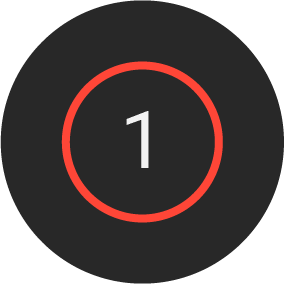
Observe your environment
Ask yourself: What does diversity mean to my company? What do we stand for? For example, if promoting women in leadership positions is a strategic objective, the learning content should reflect that.
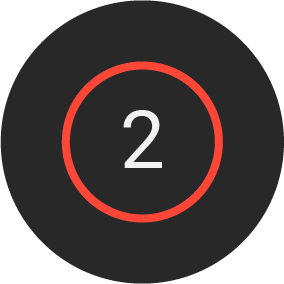
Sometimes, more is more
Featuring only one protagonist in the leaning content makes it difficult to represent diversity. Extras and avatars can be used to make the content appealing to multiple target groups, such as different nationalities represented in the company.

You are not the standard
Put yourself in different participants’ shoes: Is the learning programme designed to make it accessible to every employee? Can it be used by employees with visual or hearing impairment? For example, content might be read out from slides, because it cannot be assumed that everyone can read the text on the slides.
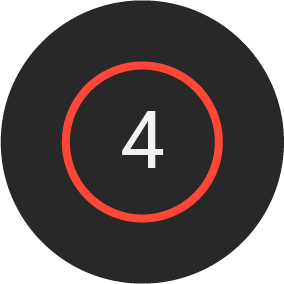
Education is the start
Reflecting diversity in your learning content is important – as is communicating to your employees what diversity means to the company and what specific measures are used to drive it. Why not outline your company’s take in some learning content on diversity?

Train the right topics
Now that we’re talking learning content: Provide content to your employees that promotes an open corporate culture, as well as open and honest interaction between employees. For example, training on “intercultural competences” can improve collaboration between different cultures.
In our next Punky Talk, we want to delve deeper into the topic of diversity in e-learning projects and speak to a company that deals with diversity on a grander scale and wants to share its experiences with you.
Contact person
